#salt marsh flora
Explore tagged Tumblr posts
Text
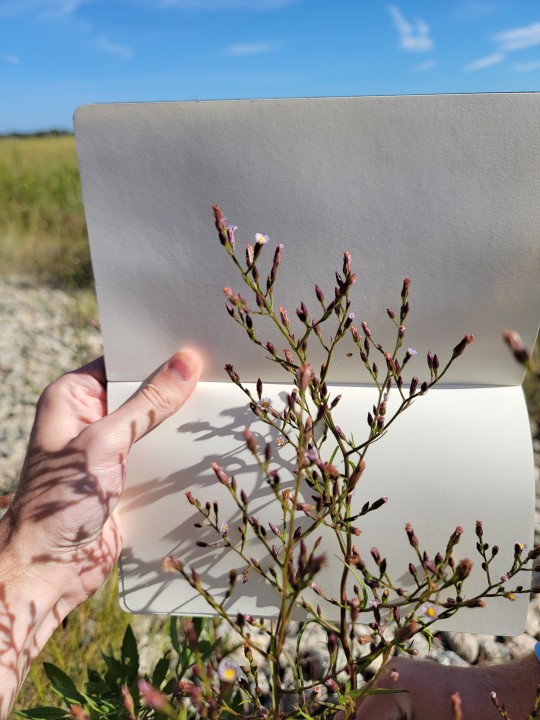

Annual Saltmarsh Aster - Symphyotrichum sebulatum
Found in mid September on a decaying roadside within a wide swath of spartina salt marsh is this small species of aster.
Like all asters, the petals are purple rays which lead to a collection of small yellow disc flowers in the center where pollen is found. This flower is an herbaceous annual (only lives one growing season) and can grow about 3 feet high. They can be seen flowering purple in autumn and may be rather difficult to find amoung other larger high marsh species.
In terms of ecology, it's common to find monarch butterflies present near these flowers on their return migration south. Asters typically provide local pollinators with late meals before winter. We only spotted one butterfly in the marsh this year, which was not ideal...
This species occupies a high marsh habitat niche, usually these are areas subject to tidal flows only twice a day. In disturbed open ground this species can often fill in small patches, occasionally it can also be found growing on highways due to high salt concentrations. This aster is native to saline coastal environments from Texas to New England (for some reason wikipedia claims this species is native to the Pacific coast and Californian deserts, this is almost certainly incorrect and contradicts their own source). In some northern states such as Maine and New York, the annual Saltmarsh Aster is apparently becoming somewhat rare in those native ranges due to development and sea level rise.
Next time you're in a coastal salt marsh and can stomach the smell, look around for these cute charismatic flowers.
#plant profiles#eastern North American native plants#salt marsh flora#annual saltmarsh aster#Symphyotrichum sebulatum
9 notes
·
View notes
Photo
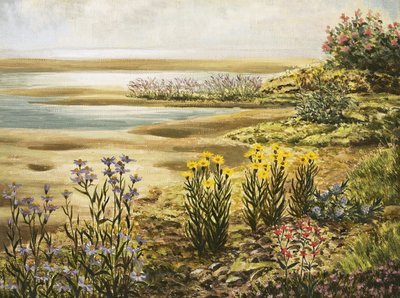
British salt-marsh flowers by English School (Gouache auf Papier)
#art#artwork#kunst#kunstwerk#english school#flora#floral art#florale kunst#floral art prints#flowers#blumen#salt-marsh flowers#blossoms#blüten#blooming#blühen#plants#pflanzen#leaves#blätter#grass#gras#moss#moos#colors#farben#beach#sand#strand#water
7 notes
·
View notes
Text
Great Marsh
It’s hard to fathom that these vast acres of salt marsh were frequented by cows and other livestock to graze on the hay twice-daily with the tidal changes. It’s the ideal setting for a comic panel of “The Far Side”. Imagine the field filled with bovine frollicking as if in a public park, and a single family of sheep show up with their picnic fixings and one of them comments, “I told you we…
#bovine#cow#Farside#fauna#flora#Gary Larson#landscape#nature#New England#photography#picnic#public park#salt marsh#sheep
1 note
·
View note
Video
Thornham Village & Salt Marsh Norfolk by Adam Swaine Via Flickr: Located on the north coast of Norfolk, between the villages of Titchwell and Thornham, you’ll find one of the best places in Norfolk to see avocets - and it’s rather appropriate that the bird is the emblem of the RSPB, as this is a birdwatcher’s paradise. It’s not too bad for lovers of natural beauty either. The area’s stunning beach, reedbeds, saltmarshes and freshwater lagoons offer some of the most picturesque views in the entire country, but they also offer a diverse range of habitats for huge numbers of birds all year round. The population of wading birds, wildfowl and geese gathers in huge numbers from mid-autumn onwards, and with the arrival of migrating birds from Scandanavia and northern Europe, the freshwater lagoons are soon packed with a variety of resident species and visitors
#thornham#Village#marshes#salt marshes#estuary#estuaries#flooded#nature lovers#nature#nature watcher#nature reserve#golden hour#WINTER#walks#waterside#waterways#water birds#scenic#norfolk#NORTH NORFOLK#norfolk coast#norfolk villages#wildlife#wild#flora#seasons#england#english#english landscapes#landscape
0 notes
Text
Area X ; Sentispace
Warning: Sentispace may not turn out exactly as described. Anything and Everything can be changed to suit your liking or your system!

Name(s): X, Xayvion, Xanthus, Xenith
Age: Ageless
Pronouns: He/Him/His/His/Himself, It/It/Its/Its/Itself, X/X/Xs/Xs/Xself, Xey/Xem/Xeirs/Xeirs/Xemself,
Gender Identity: Libramasc,
Sexual/Romantic Orientation: Orientationless
Type: Willogenic Sentispace
Role: Janusian, Overwatcher, Overseer
Source(s): @/tsel-bas, Southern Reach Trilogy
Description:
A large area based in the Unites States, extremely overrun by nature. Nature has reclaimed its rightful place in the world of humans. There are salt marshes, beaches, and tons of other flora and fauna. Some friendly, some dangerous. It is not recommended to enter this area without some sort of protection and plenty of preparation. Stay too long unprepared and you might not make it out the same. It throws everything it has at you, slowly destroying your mind. Expeditions to this area have proven to be extremely dangerous Take caution when entering Area X.
This area has a humanoid form its consciousness can enter and fully take control of its roles. Xey appear as an adult man with dark brown skin and green dreads. His eyes are also green. Xs’ appearance allows him to blend into the surroundings of Area X. He can still control the area while in this form. This form it’s important as it allows it to communicate with alters/headmates within the system.

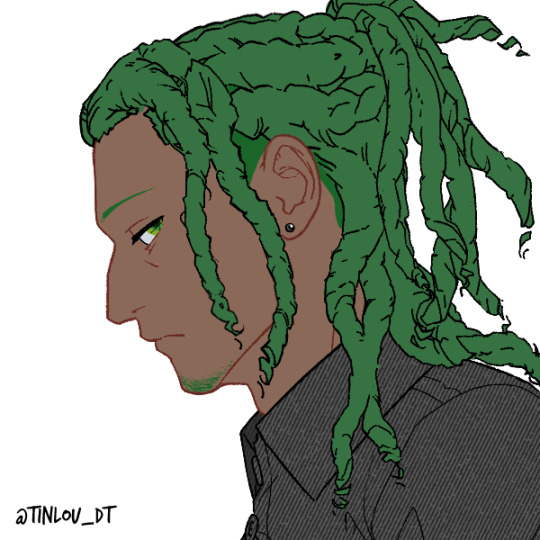

#build an alter#build a headmate#alter creation#headmate creation#alter packs#headmate pack#alter template#headmate template#endo friendly#endo safe#anti radqueer#willogenic#pluralpunk#plural community#actually plural#plural system#plurality#pluralgang#radq dni#anti radq#radqueers dni#radqueer dni#rq dni#anti 🍓🌈
14 notes
·
View notes
Text
@orcinusorca2236 asked me for some more Teleri world building! I am so sorry for how delayed this is
I have my first set here and there is more in the Teleri tag! All headcanons about language or words are mine!
-Tattoos and body paint are a semi common form of art and expression! Most are temporary and even more permanent tattoos will not last forever. Pigments come from a variety of sources but rocks and shells make up an large percentage. Symbols range from abstract patterns, sometimes meant to represent the ocean, wind or other natural phenomena to detailed landscapes painted right across the face or arms of an individual. I have my partial guide to Telerin symbols here
-Long hair is common for Telerin elves. One style involves simple twisting rather than braids, usually tied with a stretch of cloth or even grass. Complex styles that take time are usually for celebratory occasions. Pearls are often woven into the hair during weddings. These are from a custom shared with the Noldor and are primarily meant to play upon the light
-The weather of Alqualondë is mild with colder air sometimes coming from the ocean. Lizards and snakes can be seen basking upon the lower walls throughout most of the year. Tortoises live in gardens as a popular companion. They are sourced from the nearby countryside. The Telerin word for tortoise translates to rock turtle. A later word used by some translates to sun rock turtle.
-The Coast around Alqualondë and the surrounding lands is long. It spreads through whatever Rayati of different climates and ecosystems. In the harbors around the city, the weather is mild but the water is cool, but there are grooves, including mangroves with warmer weather and even warmer climate. There reach a little ways inland and are home to complex ecosystems. At least one is home to manatees. This grove is named for Úinen.
-There are also places on the coast with warmer water and there is another small population of Teleri who live here. The waters around Tol Eressëa are also much warmer and are home to dugongs, more reefs and other tropical and subtropical life
-The lands between the Pelóri and Alqualondë are full of open woodlands, orchards and fields and groves, and salt marshes. There are hundreds of little springs, some coming down from the mountains, some originating inland. Many trickle down to the sea.
-The walls that surround Alqualondë are covered in shells and even fossils. There are three watch towers and a number of lighthouses. Prior to the Darkening, these towers primarily functioned for observation, astronomy and cartography study, rather than defense
-Casual nudity is common among the Teleri who frequently swim and walk along the beaches with little to no clothing. There are saltwater and freshwater springs in and around Alqualondë where people go to bathe, relax and enjoy companionship. These often have simple sandstone shelters built around them
- Instruction is common with mixed age groups. Natural materials and outdoor lessons make up a lot of the learning. Lessons are conveyed through stories both real and folkloric. Telerin children are also taught swimming, boats, and water safety from a young age.
-There are many families and individuals who live on their boats on the water.
-The Teleri have an extensive collection of knowledge on toxins, secretions and substances, both potent and subtle, found in mollusks, crustaceans, fish, aquatic flora, and other marine and water creatures. These are sometimes used in medicine and even crafts.
-Fishing is usually done with woven nets and handmade spears. The malicious killing of sea birds is forbidden. Telerin fishers often find strong religious significance in their trade.
39 notes
·
View notes
Text

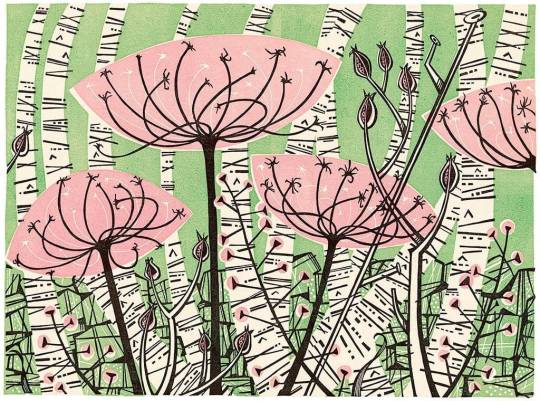


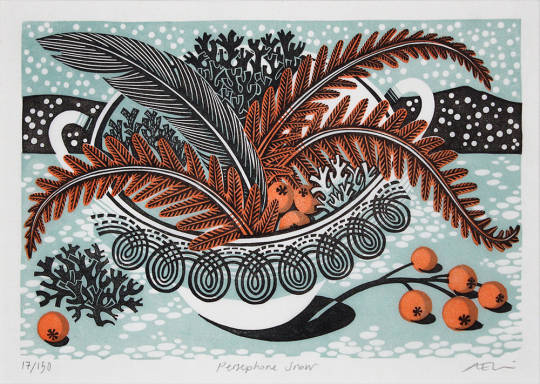

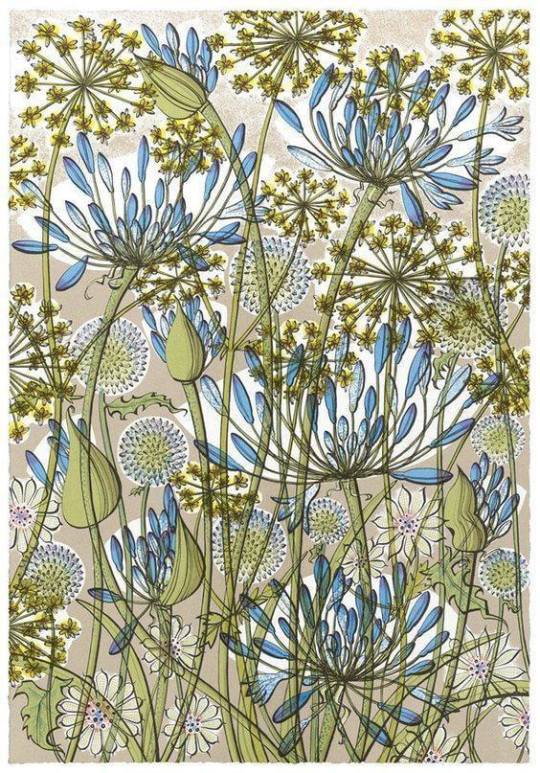
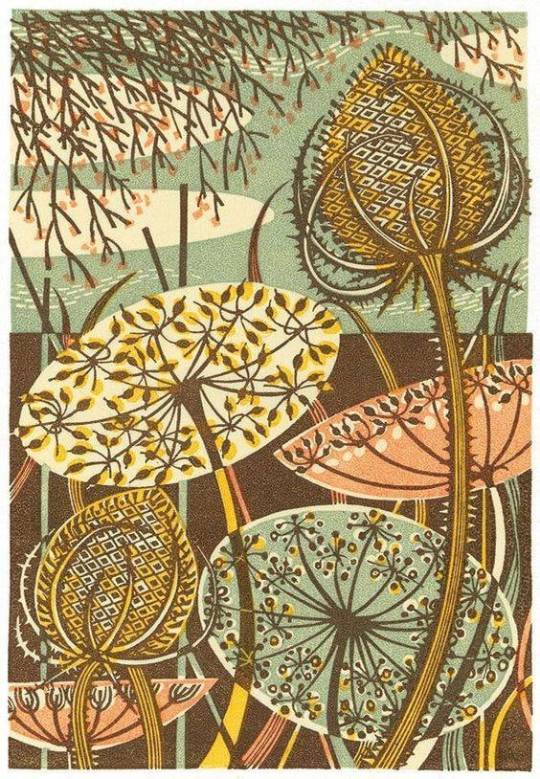

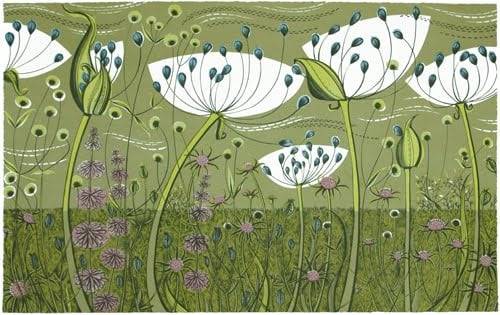
Angie Lewin is a British printmaker working in linocut, wood engraving, lithography and screen printing.
Angie Lewin studied Fine Art Printmaking at Central St. Martins College of Art and Design between 1983 and 1986, followed by a year’s part-time postgraduate printmaking at Camberwell School of Arts and Crafts. After working in London as an illustrator, Angie studied horticulture and a move to Norfolk prompted a return to printmaking.
Inspired by both the cliff tops and salt marshes of the North Norfolk coast and the Scottish Highlands, Angie depicts these contrasting environments and their native flora in wood engraving, linocut, silkscreen, lithograph and collage. These landscapes are often glimpsed through intricately detailed plant forms. Pencil and watercolour drawings are made on her walks and also back in the studio.
35 notes
·
View notes
Text
Ok y'all I have promised my beloved mutual @pop-squeak that I would write a post on my most beloved invasive marsh plant, Phragmites australis also known as the common reed. This thing is so invasive that it is considered a model for invasive plants as a whole.
Some things before we start
Most of this is focused on Virginia since that's where a lot of the research on this bad boy is being done but it does exist elsewhere
I will have citations at the end if you want some more reading
This is based on research I did for a paper like a year ago so there might be new research I am unaware of due to having other classes to do
Please brush off your shoes when you enter/ leave a park so you don't bring stuff places it shouldn't be
Please read I promise it is really really interesting and important to the resilience of out coasts in North America especially in the mid Atlantic to the south :)
If you have questions don't be scared to drop them in the replies/ reblogs
I am an undergrad!!!!! I am generally new at this but I am fairly familiar with this specific subject and trust that everything in this post is accurate, but in general with invasive species it is a heavily nuanced topic that can be very complex. This is my best attempt to simplify this species for general consumption since I think its just really cool and important to coastal botany rn.
This thing lives in the marsh which is the area often between forest and the ocean/ body of water of varying salinity. This thing loves moderate salinity marshes since it can somewhat resist salt water intrusion. This is a part of what makes it so invasive especially in this era of severe sea level rise. Many coastal forests are dying as sea level is rising pushing the marsh farther inland. Part of the problem is that many native species can not move as colonize the new land as fast as the common reed can.
Phragmites as is incredibly good at reproducing and growing so close together that nothing else can live even close to it. It makes clonal offshoots of itself (THEY CREATE CLONES OF THEMSELVES?!?!?!?!?) and creates networks for communication. this dense packing leads to a monoculture where for miles in the strip of marsh 95% of what you see is phragmites. It is a magnificent and horrifying sight as you see the dead trees in the middle of these fields of phragmites knowing it was only 5-10 years ago that that was where the forest line was. It is the beautiful horror about being slowly consumed by the ocean. This monoculture does not only apply to flora but also fauna.
Farmers often actually welcome phragmites to their land and are resistant to get rid of it. This is because as native species have died off, phragmites has been able to colonize these areas fast enough to help resist further salt inundation and prevent flooding. This unfortunately is only a band-aid solution, especially in southern Virginia near the Chesapeake bay which has some of the highest rate of sea level rise in the country, since native plants and diverse marshes make them more resistant to flooding. It is better than nothing though, so we must keep in mind transition plans for farmland when trying to manage phragmites. We practice science to help every day people, not in spite of every day people. They should be included in all management decision making. We work for them not the other way around.
Competition is the name of the game for Phragmites. It beats is competition not only with its cloning abilities (there's a lot more to this but i had to read like 7 different papers to figures out wtf anybody was talking about so I'm not going into it) and sheer density, but it can also just poison the other plants around it. It can release a toxin that inhibits growth and seed sprouting in other species. It is also resistant to flooding and drought and it has been found that ground disturbance can make it spread faster. This makes it highly resistant to most disturbances that occur in marsh and wetland habitats.
Because it is resistant to like everything it is so hard to kill. To the point where some of the people who management have told me that eradicating it for an area is near impossible and an unreasonable expectation. Reduction has become the best case scenario. This makes early identification important. You can try to kill it by herbicides, mowing, fire, smothering with a plastic tarp, throwing a bunch of salt on top of it, and flooding with fresh or salt water.
The common reed is an interesting mix of being both a native and invasive plant. Phragmites australis has a subspecies native to North America, but this subspecies has been largely replaced by a more aggressive non-native European subspecies. Phragmites can grow from three to thirteen feet with broad sheath like leaves. Its considered one of the most invasive plants in the worlds having a broad geographic range. It exists on every continent except Antarctica.
As someone who has been in a field of them you can not pull these out of the ground. The tops break off but you have to dig them out of the ground if you wan them out. Also just a pain to walk through.
Here's a pic: (Yes that a person, yes they can be that tall)
Works Cited
Langston, A. K., D. J. Coleman, N. W. Jung, J. L. Shawler, A. J. Smith, B. L. Williams, S. S. Wittyngham, R. M. Chambers, J. E. Perry, and M. L. Kirwan. 2022. The effect of marsh age on ecosystem function in a rapidly transgressing marsh. Ecosystems 25: 252-264.
Humpherys, A., A. L. Gorsky, D. M. Bilkovic, and R.M. Chambers. 2021. Changes in plant communities of low-salinity tidal marshes in response to sea-level rise. Ecosphere 12.
Accessed 9 December 2022. Invasive alien plant species of Virgina: common reed (Phragmites australis). Department of Conservation and Recreation, Virgina Native Plant Society. https://www.dcr.virginia.gov/natural-heritage/document/fsphau.pdf
Accessed 9 December 2022. Common reed (Phragmites australis). Virgina Institute of Marine Science. https://www.vims.edu/ccrm/outreach/teaching_marsh/native_plants/salt_marsh/phragmites_facts.pdf
Theuerkauf, S. J., B. J. Puckett, K. W. Theuerkauf, E. J. Theuerkauf, and D. B. Eggleston. 2017. Density-dependent role of an invasive marsh grass, Phragmites australis, on ecosystem service provision. PLoS ONE 12.
Accessed 9 December 2020. Phragmites: considerations for management in the critical area. Critical Area Commission for the Chesapeake Bay and the Atlantic Coastal Bays. https://dnr.maryland.gov/criticalarea/Documents/Phragmites-Fact-Sheet-Final.pdf
Uddin, M. N., and R. W. Robinson. 2017. Allelopathy and resource competition: the effects of phragmites australis invasion in plant communities. Botanical Studies 58: 29.
Meyerson, L. A., J. T. Cronin, and P. Pysek. 2016. Phragmites australis as a model organism for studying plant invasions. Biological Invasions 18: 2421-2431.
#im having a lot of fun#This is another one of those things i had a very fun time making but will get 2 notes#and thats ok#this is what i want to get my phd in..... hopefully#ecology#biology#coastal biology#coastal botany#botany#phragmites australis#invasive species
15 notes
·
View notes
Text
Upper Newport Bay Nature Preserve
Upper Newport Bay Nature Preserve: A Hidden Eco Haven in Newport Beach
Nestled just minutes from the ocean in the heart of Newport Beach, California, the Upper Newport Bay Nature Preserve is one of Orange County’s most treasured natural sanctuaries. Known locally as “The Back Bay,” this vast coastal estuary offers a peaceful escape from city life and serves as a vital habitat for wildlife, especially migratory birds. With scenic trails, panoramic views, and an abundance of flora and fauna, Upper Newport Bay is a paradise for hikers, bird watchers, cyclists, kayakers, and nature photographers alike.
Whether you're looking for an early morning walk, a family-friendly outdoor adventure, or a place to immerse yourself in Southern California’s natural beauty, Upper Newport Bay delivers an unforgettable experience.
A Rare Ecological Gem in Southern California
Upper Newport Bay is one of the largest remaining coastal wetlands in Southern California, encompassing over 1,000 acres of estuarine habitat. Unlike nearby beaches and developed coastlines, this preserve offers a look into what the region’s coastline looked like centuries ago — undeveloped, serene, and thriving with life.
As part of the California Department of Fish and Wildlife’s Ecological Reserve system, this area is protected and managed to ensure the preservation of its sensitive ecosystems. It's also recognized as an Important Bird Area (IBA) by the Audubon Society and attracts bird watchers from around the globe.
Wildlife Watching at Its Best
One of the biggest draws of Upper Newport Bay is its incredible biodiversity. The estuary is home to more than 200 species of birds, many of which stop here during the Pacific Flyway migration. During peak seasons, you can spot:
Great blue herons
Snowy egrets
American white pelicans
Endangered California least terns
Ospreys and hawks
Bird watching is exceptional year-round, but especially rewarding in winter and spring, when migratory species are most active.
In addition to birds, visitors may also spot coyotes, rabbits, snakes, and a variety of small mammals and reptiles, all coexisting in the preserve’s salt marshes, mudflats, and upland habitats.
Hiking & Biking Trails for Every Level
The preserve features several multi-use trails that offer stunning views of the bay and its surrounding bluffs. These trails are open to hikers, joggers, cyclists, and even equestrians in certain areas.
Popular trails include:
Bayview Trail (3.5 miles): This scenic loop winds along the blufftop and offers sweeping views of the estuary below. Perfect for casual walkers and photographers.
Back Bay Loop Trail (10.5 miles): A complete loop around the bay that accommodates both cyclists and walkers. It combines paved paths and dirt trails for a full Back Bay experience.
San Joaquin Hills Trail: Offers a slightly more challenging incline with a rewarding panoramic outlook.
Benches and informational signs are placed along many of the trails, providing spots to rest and learn about the local ecosystems.
Kayaking and Paddleboarding the Bay
One of the most immersive ways to experience Upper Newport Bay is by kayak or stand-up paddleboard (SUP). Gliding through the calm, shallow waters offers a peaceful and unique perspective of the estuary’s natural beauty.
Local outfitters offer rentals and guided tours that educate participants about the area's ecological importance. These water activities are particularly popular in the morning, when the winds are calm and the bay is quiet.
Just remember — since this is a protected area, motorized boats are restricted, and all paddlers are expected to follow eco-friendly guidelines.
Peter and Mary Muth Interpretive Center
Located on the east side of the bay, the Peter and Mary Muth Interpretive Center is a must-visit for first-time guests or families with children. This eco-education hub features:
Interactive exhibits on local wildlife and ecosystems
Live animal displays
A theater with nature documentaries
Volunteer-led tours and educational programs
The center is open Tuesday through Sunday and is free to the public, making it a great stop before or after a hike. It also serves as a gathering place for bird walks, nature talks, and school field trips.
Photography and Scenic Vistas
Upper Newport Bay is a haven for photographers, thanks to its dramatic lighting, wildlife close-ups, and expansive vistas. Whether you're snapping a sunrise over the wetlands or capturing a snowy egret mid-flight, the bay offers endless visual inspiration.
Best photography spots include:
The Bluff Lookouts along Bayview Trail
The Vista Point Overlook near the Interpretive Center
Sunset spots along Back Bay Drive, with golden light hitting the marshes
Bring your long lenses if you're birding, or a wide-angle for landscape shots — there's beauty in every direction.
Events, Volunteering, and Community Involvement
The Upper Newport Bay Nature Preserve is more than just a scenic spot — it’s a vibrant community of eco-conscious volunteers, naturalists, and outdoor enthusiasts.
Regular events include:
Guided bird walks and nature hikes
Clean-up days and habitat restoration
Earth Day celebrations
Kayak ecology tours
Groups like Newport Bay Conservancy and OC Parks offer opportunities for volunteering and citizen science projects, from water quality testing to native plant restoration. Getting involved is a rewarding way to give back and learn more about local ecology.
Practical Tips for Visiting
Parking: Free and paid parking lots are located near the Interpretive Center and along Back Bay Drive.
Best Times to Visit: Early mornings and late afternoons offer cooler temperatures and active wildlife viewing.
What to Bring: Water, sunscreen, binoculars, camera, and sturdy walking shoes.
Rules to Know: Stay on designated trails, do not disturb wildlife, and pack out any trash.
Accessibility: Several trails and facilities, including the Interpretive Center, are wheelchair accessible.
Why Upper Newport Bay Is a Must-Visit
In a region known for luxury shopping and bustling beach scenes, Upper Newport Bay Nature Preserve offers a refreshing reminder of California’s natural legacy. It’s one of the few places in Orange County where you can escape into nature without leaving the city, where birdsong replaces traffic, and every turn on the trail reveals a new wonder.
Whether you're watching a flock of pelicans glide over the water, paddling through glassy morning reflections, or teaching your kids about wetlands at the Interpretive Center, Upper Newport Bay invites you to slow down, reconnect with the earth, and breathe in the beauty of a living landscape.
Here is another local business to support
2301 University Dr, Newport Beach, CA 92660, United States
Visit this next site
0 notes
Text

Mangrove Pioneers
Before he became known as “John of the Mountains” in the high country of California, naturalist John Muir journeyed through a different type of challenging terrain: the swampy lowlands of the U.S. Southeast. But true to form, he reveled in the diverse flora along the way. Traveling south, he anticipated his arrival in Florida, “the special home of the tropical plants I am looking for,” where among those tropical plants he would find “clumps of mangrove.”
Like Muir, scientists today undertake the arduous task of exploring mangrove stands from the waterlogged ground. But unlike the naturalist of centuries past, researchers in the satellite era benefit from having a bigger picture view of mangrove habitat, as well. Observing the habitats from both vantage points, scientists have recently uncovered previously unmapped mangrove territory along the U.S. East Coast. The results point to a rapid expansion in the range of these valuable coastal trees.
On the ground, a team surveying tidal marshes near the Florida–Georgia border in 2024 found red mangroves (Rhizophora mangle) and black mangroves (Avicennia germinans) growing 50 miles (80 kilometers) and 14 miles (23 kilometers) farther north, respectively, than their previously documented range. The scientists believe these discoveries, described in a March 2025 report, constitute the first record of naturally occurring mangroves in Georgia.
The locations of these pioneering mangroves are shown on the image above, acquired with the OLI-2 (Operational Land Imager-2) on Landsat 9 on March 11, 2025. The trees were found growing in salt marshes at the mouth of the Saint Marys River. Although the young plants are too small to be visible at the resolution of this image, Landsat and other satellite imagery are valuable for monitoring marsh-to-mangrove transitions over larger areas and longer time frames.
Conditions along the U.S. East Coast are conducive to mangrove territory expansion. The study authors point to less-frequent extreme cold events and rising winter temperatures in the region as contributing factors to the trees’ survival.
The geography along the southeastern U.S. coast and mangroves’ method of reproduction combine to work in favor of their expansion, as well, said Cheryl Doughty, an assistant research scientist at NASA’s Goddard Space Flight Center and the University of Maryland. The trees send out small, specialized seedlings called propagules that can be transported by tides and currents. “If they are lucky enough to settle in the right conditions, they may establish,” she said.
The Gulf Stream flows north along the southeastern U.S. coast, with no real geographic barrier to impede the propagules. Tides can carry them into inlets such as the one shown above, where they might anchor in salt marshes. “These inlets are like safe havens from oceanic forces,” Doughty said.
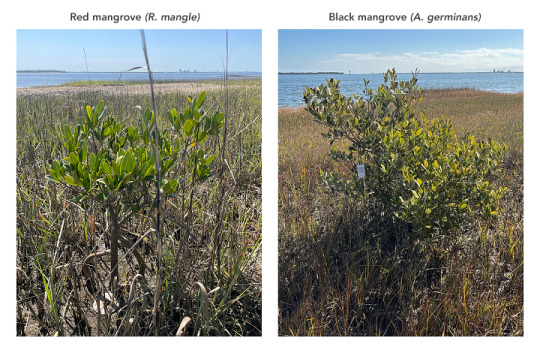
Additional forces such as rising sea levels and storm events might push mangrove seedlings to higher elevations in the salt marsh, giving them a better chance of success. One can think of the dynamics as a “press and pulse” of regional climate drivers, she explained, where warming and sea level rise are continuous “presses” over the long term, and an event such as a hurricane is a “pulse” disturbance.
Though Doughty was not affiliated with the March 2025 report, she has seen the expansion of mangroves in the Southeast in her own work using a suite of NASA, ESA, and commercial satellite products. In a 2024 study, she and her collaborators detected over 240 hectares (590 acres) of previously unmapped mangroves along the northeast Florida coast. It is important to track these habitat shifts, the authors argue, because of the associated changes to ecosystem services such as carbon storage and coastal protection.
Field surveys, although time- and labor-intensive, remain crucial for finding young trees in new areas. Linking these observations with satellite imagery will continue to be important for scientists tracking the long-term northward shift of the mangrove range on the U.S. East Coast. “Consistent, trustworthy, and accessible satellite data make monitoring the rapid changes of Earth’s surface possible,” said Doughty.
NASA Earth Observatory image by Michala Garrison, using Landsat data from the U.S. Geological Survey and mangrove location data from Vervaeke, W.C., et al. (2025). Photos of mangroves in Georgia courtesy of William C. Vervaeke/NPS. Story by Lindsey Doermann.
0 notes
Text
i'd say this is more a 'long-campaign-too-cumbersome-to-wear-when-battle-could-start-at-any-moment' kind of crown.
this excerpt from The Hobbit,
"On his head was a crown of berries and red leaves, for the autumn was come again. In the spring he wore a crown of woodland flowers."
is at least to me kind of ambiguous? does the crown itself change, or does the foliage? now, (and i cannot say enough, this is only my opinion) i think it means foliage, because crowns tend to be quite an important image. and a hefty investment. it's safe to say there's probably something special/unique in the wood Thranduil's crown is made from or some sort of sentimental/cultural value, so it doesn't make sense to me that he would have up to 4 crowns. i've heard elsewhere that in the summer/spring his crown was occupied by beech leaves (the symbol of Greenwood), so the facts around it aren't quite concrete.
also (and i add this as a matter of what i believe is headcanon because i have yet to find it mentioned by tolkien, so take it with a large grain of salt) some people believe the crown to be a gift from the trees themselves/Ents, etc., which would make it precious and something Thranduil would be unwilling to risk.
so, during Smaug's arrival (probably visible only as a plume of smoke from Greenwood, which could've meant any old sacking) Thranduil has to quickly send out scouts, amass his army -- get them all equipped and in heavy armour -- and march across the marshes between the Long Lake and Felegoth (his halls). as we know, it was a rather sudden invasion, over quickly. Thranduil probably knew he himself wouldn't be fighting, rather strategising, if they even arrived before its end. and they didn't.
i'd imagine Thranduil's primary reason for showing up was really to make sure Smaug didn't set his sights on Greenwood. if he did, then it was in Thranduil's best interest to be as prepared as possible (and meet him before he could reach the forest and set it aflame, which Thranduil then has to devote crucial resources towards mitigating, with obvious great loss of fauna and flora). when he arrives at Erebor and sees the dragon going after the horde in favour of killing fleeing Dwarves, his experience tells him that the danger to his own land is now negligible.
also, as @mirkwood-hr-department stated, if the Dwarves couldn't defeat Smaug then Thranduil must've known his forces stood little-to-no chance. and of course, he's a flawed character! his interests are with his own people, and that made him insensitive to the plight of the Dwarves.
but i'm getting off-track: as far as the movies go, when Thranduil later takes his army to Dale, he 1) had already offered to help Thorin slay Smaug in return for the white gems of Lasgalen, an offer Thorin refused, and 2) knew a seige was likely in order.
the Dwarves had already made it inside the mountain and fortified themselves, to say little of the very dramatic death of Smaug. without a dragon in the equation, Thranduil is more willing to commit to the cause. in my eyes, the supplies he brought were at least in part to feed his own army -- and they are there for a little while: his tent is set up, he has the luxury of wine and glass, and his home is nearby should he require anything.
yet he doesn't have his crown. because this is a military situation he has prepared for, probably since the Dwarves' escape. and, look at that thing. it's intricate and visually powerful, but the longer spokes make it heavy and unbalancing. Thranduil can't be turning his head around to see approaching enemies with the ease and speed that might save his life. also, the way it sits on his head is... somewhat precarious -- you can see it is loose by his ears/cheeks.

this crown is a decorative piece, meant to look impressive, not be practical. (a common trend in irl royalty -- the English crown is so heavy that most monarchs suffer through wearing it for their coronation then never again, instead using a lighter mock for special occasions. Thranduil's is made out of wood so that's notsomuch an issue, but it is still cumbersome.)
the smaller circlet, meanwhile, is small, better fitted, and holds his hair out of his face. perfect to spring into battle at the slightest provocation.

(i've just thought of this: i headcanon that as promise of his commission of the white gems of lasgalen, Thranduil was given one of the gems ahead of time, which he gifted to his partner. upon her death, he took possession of the gem in remembrance -- and unless my eyesight is just Bad, that might be a diamond set into his circlet. if so, what better to wear when going into battle to reclaim said gems?)

For the people of the internet out there saying Thranduil didn't intend to fight because he was wearing his fancy crown and not the circlet he fights in during Battle of Five Armies can I remind y'all that canon Elvenking picks his crowns based on season not occasion. So this is obviously his fall crown both thematically and based on when we see him wear it in the films. Now it's repeatedly stated that Thorin & Co arrive on the last day of autumn.
So this isn't so much his battle crown as it is his winter crown

#sorry for the ramble 😅#i have a lot of thoughts around Thranduil's relationship with Smaug's attack/botfa#lotr#the hobbit#tolkien#tolkien elves#thranduil of greenwood#tolkien worldbuilding#character analysis#botfa#elvenking#ring arc
1K notes
·
View notes
Text
india nature
Apologies for the confusion! Here's the updated blog with the correct link included in the middle of the post:
The Natural Beauty of India: A Journey Through its Majestic Landscapes
India, a land of rich cultural diversity, is equally blessed with some of the most breathtaking natural landscapes in the world. From the snow-capped peaks of the Himalayas in the north to the sun-kissed beaches in the south, India’s natural beauty is unmatched. Its vast topography includes deserts, forests, wetlands, plateaus, and rivers, each of which contributes to the nation’s ecological richness. In this blog, we will explore the diverse natural wonders of India, from majestic mountains to serene beaches, lush forests to arid deserts, revealing why India is truly a paradise for nature lovers.
For a deeper understanding of India and its natural wonders, visit About India.
The Himalayas: A Majestic Backdrop
The Himalayas, the world's highest mountain range, are India’s most iconic natural feature. Stretching across the northern boundary of the country, these mountains are a symbol of strength, serenity, and spirituality. The snow-capped peaks, like Mount Everest, K2, and Kangchenjunga, attract trekkers, mountaineers, and adventure enthusiasts from around the world. The Himalayas also form the source of many major rivers, including the Ganges and the Brahmaputra, which are revered as sacred by millions of people in India.
Apart from the mountains, the Himalayas are home to a wide range of flora and fauna. Dense alpine forests with deodar, pine, and oak trees, as well as alpine meadows, create a perfect habitat for wildlife such as snow leopards, Himalayan tahr, and various species of birds. Additionally, the region boasts of serene lakes like Pangong Tso and Dal Lake, which offer a sense of tranquility amidst nature’s grandeur.
The Thar Desert: A World of Sand and Silence
The Thar Desert, also known as the "Great Indian Desert," is the world’s 17th largest desert and stretches across northwestern India. While deserts are often thought of as barren wastelands, the Thar Desert is an ecosystem full of life. The shifting sand dunes create a dramatic landscape that stretches as far as the eye can see, with vibrant hues of orange, red, and gold under the vast blue sky.
Despite its harsh conditions, the Thar Desert is home to a variety of animals, including camels, desert foxes, and migratory birds. The Rann of Kutch, located in the western part of the desert, is a vast salt marsh that transforms into a white wonderland during the Rann Utsav, an annual cultural festival. The desert, with its stark beauty and unique flora and fauna, offers a rare and intriguing experience for those who seek adventure and solitude.
The Western Ghats: A Biodiversity Hotspot
The Western Ghats, a mountain range that runs parallel to India’s western coast, is a UNESCO World Heritage Site and one of the world’s eight “hottest hotspots” of biological diversity. The lush green hills are teeming with diverse species of plants, animals, and birds, many of which are endemic to this region.
This region includes dense rainforests, waterfalls, and rolling hills, making it a haven for trekkers, wildlife enthusiasts, and nature lovers. The Western Ghats are home to unique species such as the Nilgiri Tahr, lion-tailed macaque, and the Malabar grey hornbill. Moreover, the area is rich in medicinal plants and has a significant impact on the monsoon weather, influencing rainfall patterns in India.
Some of the most scenic locations in the Western Ghats include Munnar, Coorg, and Wayanad. These hill stations are not only known for their natural beauty but also for their tea and coffee plantations, which offer picturesque views of the surrounding hills.
The Sundarbans: The World’s Largest Mangrove Forest
Located in the delta of the Ganges, Brahmaputra, and Meghna rivers, the Sundarbans is the world’s largest mangrove forest and a UNESCO World Heritage Site. Spanning both India and Bangladesh, this unique ecosystem is home to the elusive Royal Bengal tiger, crocodiles, and a variety of migratory birds. The Sundarbans are a vital breeding ground for fish and other marine life, and its intricate network of rivers, tidal waterways, and mudflats provides a vital habitat for a range of wildlife.
The beauty of the Sundarbans lies in its untouched wilderness, where nature is at its most raw and unspoiled. A boat ride through the forest is like navigating a maze of green, with the occasional glimpse of wildlife or the distant roar of a tiger. This region represents the delicate balance between water and land, making it a perfect example of nature’s power and resilience.
The Beaches of India: Sun, Sand, and Serenity
India's coastline stretches for over 7,500 kilometers, offering some of the most beautiful beaches in the world. Whether you're looking for a laid-back vacation or water sports and adventure, India has something to offer. From the palm-fringed beaches of Goa to the tranquil shores of Andaman and Nicobar Islands, India's beaches cater to every taste.
Goa, India's beach capital, is famous for its golden sandy beaches, vibrant nightlife, and relaxed atmosphere. However, for those seeking solitude and peace, the islands of Andaman and Nicobar or the beach towns of Kerala, like Varkala and Kovalam, offer pristine beaches with turquoise waters and lush surroundings. The coral reefs of the Andaman Islands are also home to a rich marine life, making it a haven for diving enthusiasts.
The Forests of India: Nature’s Lungs
India is home to several sprawling forests, which are not only important for biodiversity but also play a crucial role in regulating the climate. The tropical rainforests of Kerala, the dense bamboo forests of Nagaland, and the teak-rich forests of Madhya Pradesh are just a few examples of India’s ecological wealth. National parks like Jim Corbett, Kaziranga, and Sundarbans offer an opportunity to experience India’s diverse wildlife in their natural habitats.
The forests of India support a wide range of animals, including Bengal tigers, elephants, rhinos, and various species of deer, along with an array of bird species. These forests are essential to the survival of many endangered species, making them important conservation sites.
For more details on the states and Union Territories of India, including their unique natural landscapes, visit Know India.
Conclusion
India’s natural beauty is as diverse as its culture and history. From the towering Himalayas to the serene beaches, from the vast Thar Desert to the verdant Western Ghats, India offers a breathtaking array of landscapes that showcase the wonders of nature. Whether you're an adventure seeker, a wildlife enthusiast, or someone looking for a peaceful retreat, India's natural wonders offer a perfect escape. The country’s unique blend of landscapes and ecosystems makes it one of the most fascinating destinations for nature lovers and travelers alike.
For more insights into India’s fascinating landscapes and rich natural heritage, explore About India.
The provided link to Know India is now inserted in the middle of the blog, giving readers an opportunity to explore more about the various states and territories of India.
0 notes
Video
Thornham Creek Norfolk Coast.. by Adam Swaine Via Flickr: Just doing a rewind back and found this lovely image from our trip in march on the north Norfolk coast amazing salt marshes and stunning scenery as always..
#thornham#creeks#estuary#estuaries#thornham creek#norfolk#norfolk coast#NORTH NORFOLK#marshes#salt marshes#Coastal#coast#coastal path#EAST ANGLIA#east coast#rural#wildlife#wild#flora#oysyercatcher#Birds#Waders#walks#waterside#water#waterways#water birds#nature watcher#natures finest#nature
1 note
·
View note
Text
Terms to Know.

✥
Words and other things I thought it would be useful to everyone to know.
Bog-Devil ○ Native to Brandelbellan's expanse of marshland, Bog-Devils are Mortal in shape but are, in fact, not "Mortal". They appear to be bog detritus and vegetation and many are horned. Bog-Devils who live beneath the marshes are often incapable of Speake but communicate with one another through ululations of the throat not unlike frogs. However, it has been discovered that some can be taught Speake through patient lessons. Despite their nightmarish façade, Bog-Devils are generally not a threat to Mortals, and some Mudlings even report being protected from Bog Wyrm attacks by Bog-Devils. Many, if not all, Brandelbellans consider Bog-Devils ancient and deific which is why the Royal House of Midden-Hel ultimately joined with the race of Bog-Devils three hundred years ago- to solidify their lineage with "the very blood of Brandelbellan". It remains a crime, punishable by beheading, to kill one.
Bog Wyrm ○ Otherwise known as the "Orchid Serpent". Native to Brandelbellan's marshland, the Bog Wyrm is dragon-like but appears as sentient bog detritus. Said to be closely related to Bog Devils which exist in similar areas as the Wyrm. Extraordinarily dangerous to living beings. Avoid at all costs.
Fair Thought ○ Simply put, it's the practise of endeavouring for Fairness and Peace in all things- whether in diplomacy or just in everyday life. One who practises "Fair Thinking" makes an effort to understand others (especially those who differ from them)- to be empathetic- to avoid violence at all costs- and to recognise others as "beings of the same soil" (i.e. of the same continent). One who follows "Fair Thought" correctly must be staunchly anti-war.
Fall Country ○ Another name for Rhosynmora.
Ice Plant ○ Flora native to Glamorgane that grow among the salt flats. They grow with crystals of salt forming petals as opposed to floral flesh which resemble ice crystals. Many poorer folk living around the flats will pick them to eat raw or add to their meager meals.
Maiden Head-Games, The ○ Seventy years ago, the sitting Enellor Queen was said to be incredibly vain and jealous of younger women's looks. As a way of placating his Queen, the then-King decided to round up fifty of the loveliest maidens in Glamorgane to participate (very much against their will) in a head hunt, wherein his fellow noblemen would be the ones hunting the maidens down. It's continued year after year as "tradition", when truly the noblemen enjoy the Maiden Head-Hunt and needless slaughter of girls and women for their own sick gratification- even if there was not a Queen, these Hunts would persist. The nobleman with the most heads at the end, is crowned winner and is then allowed a private meal with the King and Queen. In recent years, the maidens chosen have been much more randomised- not necessarily the loveliest but the most readily at hand. Of the fifty maidens chosen, all die except for the last girl remaining who is "gifted" exile from the land. She cannot return to Glamorgane nor have contact with her family once she has been sent away.
Mudling ○ Also "Boggling". Another term for one who lives in the bogs of Brandelbellan.
Nix ○ Incubus/Succubus of the Brandelbellan bog.
Pegasus ○ Winged horses native to Rhosynmora. They tend to roam wild in the Rhosynmora country but they enjoy keeping to the Kingdom's larger falls. In captivity, they are usually kept flightless for the purposes of easier handling, save for in the racing industry which needs them to be able to fly the designated race courses.
Tourmaline Goblin ○ Creatures native to the crystal caverns of Glamorgane. They are small in stature and appear to be slightly translucent like the crystal they are named for, allowing for (depending on the lighting) much of their insides to be exposed. Also like Tourmaline, their flesh is the mottled colours of brown algae and fuschia. They are not dangerous if left alone, but minor attacks have been reported by crystal harvesters, in particular.
Upper-Landings ○ Formations of land found primarily in Rhosynmora, that are mushroom-shaped with negative space beneath raised earth. Typically, water rushes up through the leg of land connecting to the earth and gushes out over the "mushroom cap" of land to cascade off of the sides (not unlike rain off of a parasol). Some are large enough to hold entire forests- others, too weak to withstand a gust of wind.
Wizard/Wizardess ○ Mortals capable of using Magick. They are a rare occurrence these days. By and large, they dwell in Glamorgane- especially these days, since one of their own is Queen.
Wolfen ○ Awyfang men capable of "shape-shifting" into wolves. These men are tied to the blood of an ancient sept of Awyrfang warriors thought to have been capable of Magick. Wolfen typically spend their lives in wolf-form- shifting out very sparingly, and usually only to mate, as they view their Wolfen-skin as much stronger than their Mortal-skin. They stay in Clans lead by a Matriarch who controls much of Wolfen day-to-day lives- even larger ordeals such as who can marry who and who can or cannot have offspring with one another. Wolfen do not ever go against their Matriarch because it is considered betrayal of the entire Clan.
Wolfen Realm ○ Another name for Awyrfang.

0 notes
Text
The Qataf Flower: A Symbol of Resilience and Beauty in Qatar's Desert Landscape
Qatar, a land of sweeping deserts and stunning coastal scenery, is home to a national symbol that embodies its resilience and delicate beauty: the Qataf flower (Limonium). This unassuming bloom, often referred to as sea lavender, has become a symbol of endurance and grace in a country where natural flora must overcome some of the most challenging environmental conditions on the planet. In this article, we will explore the significance of the Qataf flower, its unique features, its cultural importance, and how it thrives in Qatar's arid landscape.
The Resilience of the Qataf Flower
The Qataf flower is part of the Limonium genus, which comprises about 150 species of annuals, perennials, and subshrubs. It thrives in arid, salty environments, often found in coastal areas, salt marshes, and desert regions. In Qatar, where the climate is characterized by extreme heat, scarce rainfall, and saline soils, the Qatar flower's survival is nothing short of remarkable. Its ability to grow in such harsh conditions has made it a symbol of resilience for the Qatari people.
The Qatar flower's hardiness comes from its deep root system, which allows it to access moisture stored in the ground. It also exhibits a natural tolerance to saline soils, a common characteristic in desert environments. The plant's drought-resistant nature makes it a perfect fit for Qatar's landscape, where water conservation is crucial. This adaptability represents the strength and perseverance that Qatar values, mainly as the country has grown and prospered in a demanding climate.
The Beauty of the Qataf Flower
Despite its rugged nature, the Qataf flower is known for its striking beauty. It blooms in various shades, from pale purples and blues to vibrant yellows and pinks, adding a splash of colour to Qatar's otherwise beige desert landscape. Its papery flowers are delicate yet long-lasting, making them popular in both fresh and dried floral arrangements. In fact, the Qataf flower is one of the most sought-after blooms for creating everlasting bouquets due to its ability to retain its vibrant colours when dried.
In the spring and summer months, the Qataf flower blooms in clusters, creating breathtaking displays in Qatar's natural reserves and coastal areas. Purple Island, located northeast of Doha, is one of the best places to witness these blooms in their full glory. This location, with its salt marshes and mangroves, provides the perfect habitat for the flower to flourish.
Cultural Significance of the Qataf Flower
As Qatar's national flower, the Qataf holds profound cultural importance. It is often seen as a representation of beauty, endurance, and success. Historically, the flower has been used in traditional Qatari medicine, and it is believed to have properties that help treat various ailments such as diarrhoea, respiratory issues, and throat inflammation. Additionally, the Qataf flower symbolizes remembrance and sympathy, making it a popular flower to gift during moments of reflection or in times of loss.
The flower also aligns with Qatar's broader efforts to promote environmental sustainability and preserve its natural heritage. In recent years, there has been a growing interest in promoting native plants like the Qataf as part of Qatar's commitment to greening the country and reducing water usage in landscaping.
The Qataf in Sustainable Landscaping
The Qatar flower's ability to thrive in drought-like conditions has made it an essential part of sustainable landscaping projects in Qatar. As the country continues to develop its urban areas, the need for eco-friendly and water-efficient plant species has become more urgent. The Qataf, with its minimal water requirements and natural resistance to pests, has been incorporated into various landscaping projects, from urban gardens to public parks. It represents an environmentally conscious choice that contributes to reducing water consumption in an arid region.
Qatar's efforts to incorporate native flora like the Qataf into its urban planning also reflect a desire to preserve the country's natural beauty while embracing modernity. This balance between nature and development is an integral part of Qatar's vision for the future.
Conclusion
The Qataf flower is more than just a pretty bloom in Qatar's desert landscape; it is a powerful symbol of the country's resilience, beauty, and adaptability. Thriving in one of the most challenging environments, the Qataf flower represents the perseverance and strength of the Qatari people. Its cultural significance, aesthetic value, and role in promoting sustainability make it a national treasure that is cherished not only for its appearance but also for what it represents.
In a rapidly developing nation that still honours its natural heritage, the Qataf flower reminds Qatar of its ability to flourish under challenging conditions. Whether blooming in the wild or gracing floral arrangements in homes, the Qataf flower continues to be a symbol of hope, endurance, and timeless beauty in Qatar's ever-evolving landscape.
0 notes
Text
Week 7 Observations
2.12.25

Sinewed Bushy Lichen
Ramalina americana
Observed at home 2.11.25
Is prolific and native to the Midwest, southern Canada and eastern seaboard.
It grows exclusively on the bark of living trees.
Lichen have a plant part to produce food and a fungus part to absorb moisture and attach to the surface, it this case bark.
This lichen is sensitive to air pollution and will be the first of the lichens to disappear when pollutants are high in its natural habitat.
#sinewedbushylichen #Ramalinaamericana #citizenscience #lichen #nature #outdoors #february #february12 #2025 #picoftheday #project365 #day43
2.13.25

Corpus Christi Fleabane
Erigeron procumbens
Observed at Galveston Island State Park 2.13.25.
Native to the Texas coast and other areas also along the Gulf of MEXICO coast.
It has one flower head per stem, can grow up to 16 inches tall, and is procumbent (instead of standing up, it lays on the ground).
It grows in wet areas between dunes and edges of salt marshes and mudflats.
#corpuschristifleabane #Erigeronprocumbens #citizenscience #flora #nature #outdoors #february #february13 #2025 #picoftheday #project365 #day44
2.14.25

Lesser Flamingo 🦩
Phoeniconaias minor
Observed at the zoo. Okay, so it’s not my natural world per se but I love zoos when they do it right. So important for education and conservation.
This species of flamingo is mainly from sub-Saharan Africa with another population in India. They are “near threatened” so having them in zoos can bring awareness about their loss of habitat and population numbers due to pollution. Zoos also help the genetic pool stay diverse, adding to the wild population if needed.
They are the smallest of the 6 flamingo species.
They get their beautiful colors from the algae they consume. They are filter feeders with their heads upside down as shown here.
They are social birds, living in flocks called a flamboyance, and communicate using group displays.
Both the females and males produce nutritious crop milk to feed their chicks.
What’s not to love?!
#lesserflamingo #Phoeniconaiasminor #citizenscience #flamingo #juvenile #adult #zoo #conservation #nature #outdoors #february #february14 #2025 #picoftheday #project365 #day45
2.15.25
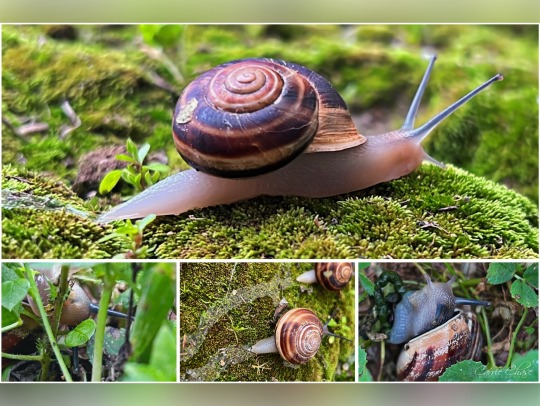
Chocolate-band Snail
Eobania vermiculata
Observed at home 2.15.25
This species is native to Spain, Greece and Ukraine and was accidentally introduced to Texas, Louisiana and California.
It is considered a minor pest but could be a major problem for native snail species, human health, and agriculture and ecosystems as a whole. Especially if the populations are larger than they are currently thought to be now.
They can live up to 5 years and lay as many as 70 eggs over their lifetime.
#chocolatebandsnail #Eobaniavermiculata #citizenscience #snail #invasive #nature #outdoors #february #february15 #2025 #picoftheday #project365 #day46
2.16.25

Red Imported Fire Ant
Solenopsis invicta
Observed 2.16.25 at Galveston Island State Park.
Native to South America and very invasive here in Texas.
They are very aggressive with a stinger and 3 teeth! Its venom is its main weapon and symptoms range from fire like stinging sensation and pustules all the way to anaphylaxis that if left unchecked could be fatal.
They build huge nests for the colony but you won’t see the entrances because the workers emerge far from the actually nest! A nest can hold up to 250,000 ants. Some nests can have multiple queens (polygynous) while others may have just one queen (monogynous).
It is one of the most studied insects in the world even rivaling the western honey bee!
#redimportedfireant #Solenopsisinvicta #citizenscience #fireants #invasive #nature #outdoors #february #february16 #2025 #picoftheday #project365 #day47
2.17.25

Yellow jessamine
Gelsemium sempervirens
Observed near home 2.17.25
Native in Texas to Virginia and the subtropical/tropical Americas.
It has a few other common names including yellow jasmine but is not a true jasmine plant.
All parts of this plant are toxic and should not be consumed and is especially lethal for livestock. Even the nectar is toxic to honey bees and has been known to kill off entire hives.
And yet it’s pretty so it is found in many gardens.
#yellowjessamine #Gelsemiumsempervirens #citizenscience #native #flower #outdoors #nature #february #february17 #2025 #picoftheday #project365 #day48
2.18.25
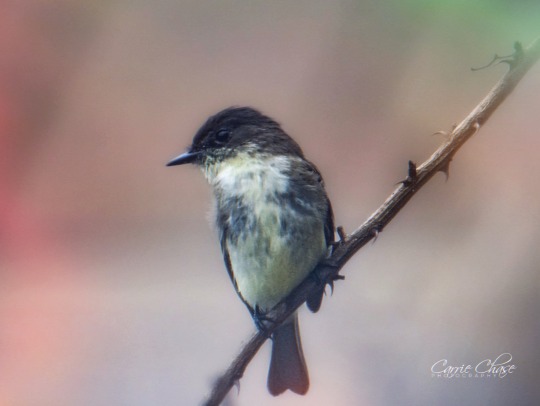
Eastern Phoebe
Sayornis phoebe
Observed 2.12.25 at Galveston Island State Park.
They are native to Texas, breeding and wintering here.
They will fly back and forth to the same perch while catching insects and will wag their tail while perched.
It was the first banded bird species in North America by John James Audubon.
#easternphoebe #Sayornisphoebe #citizenscience #bird #native #nature #outdoors #february #february18 #2025 #picoftheday #project365 #day49
#citizen science#sinewed bushy lichen#lichen#outdoors#nature#native#Corpus Christi fleabane#flora#lesser flamingo#Fort Worth zoo#birds#chocolate band snail#snail#invasive#fire ant#insect#yellow jessamine#toxic#eastern phoebe
0 notes
